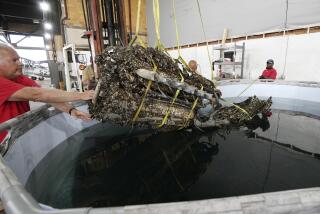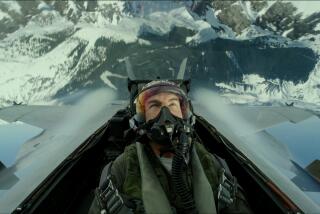A Military Plane Soars in Peacetime
NASHUA, N.H. — The C-47 shudders as Ron Fox practices a stall.
The plane is supposed to fall gently as he points its nose upward. Instead, it bucks violently, flips upside down and plummets.
Far too frisky for its 60 years, this Gooney Bird is living up to its nickname.
But after a few moments, the olive-drab plane is right-side up, prompting a laugh from Fox’s copilot. Harald Hamre, 45, of Manchester, can be relaxed about this. He began flying as a teenager and knows all the C-47’s quirks.
Despite such theatrics, many of the 3,500 C-47s still flying worldwide aren’t pampered air show entries. Even with six decades and three wars behind them, these planes earn their keep.
Hamre owns Allied Air Freight of Nashua, one of more than a dozen companies nationwide to use refurbished C-47s. Relatively inexpensive, the planes are ideal for small businesses breaking into the freight market. “There’s not another aircraft in the world for $200,000 that will carry as much cargo,” Hamre says.
Known to civilians as DC-3s, they haul cargo of all sorts, some of it too big to get on board jets. Ask Michael Dalton, spokesman for Corporate Express in Pontiac, Mich., which owns six of the aircraft. His company has hauled diaper bags, cigarette wrappers, pandas from China and bottle caps from Coca-Cola.
Other companies have ferried dolphins, gorillas, chickens, sea lions, newspapers, automobile parts, even the moon buggy.
The cargo has always been dramatic. From 1941 to 1945, Douglas Aircraft built roughly 10,000 of these “Skytrains” to carry soldiers and supplies during World War II. That began one of the longest military careers of any plane, says Dave Menard, a spokesman for the U.S. Air Force Museum at Wright-Patterson Air Force Base in Ohio.
On D-Day, they were the first Allied planes to cross the English Channel. Gen. Dwight D. Eisenhower, who commanded that invasion, lauded the C-47 as one of four weapons--with the Jeep, bazooka and atomic bomb--that helped win the war. Later, the planes carried troops and gunships in Korea and Vietnam.
They remain appealingly versatile. The C-47s don’t need long runways. Their fat wheels can land on nearly any surface, from beach to tarmac. And their large cargo doors allow them to carry those large payloads.
Of course, the plane does present problems. Remember those flips?
“If you do a hard stall, you usually flip onto your back,” says Jeff Vantine, manager of Rapid Air in Grand Rapids, Mich., which flies two C-47s. “That’s probably the only fast thing that plane does.”
And because of its age, the plane requires a lengthy preflight inspection--more than 1,000 items to check. That irritates Hamre because he can’t just start up and fly off. He admits that his plane, known as “Precious Cargo,” needs a bit of babying.
*
But the C-47 is still popular. Pilots appreciate its physical endurance and design. “They are workhorses. They just don’t die,” Vantine says. “You just keep putting new engines on them, and they keep on going.”
Menard suggests that the plane has lasted because it’s not pressurized like modern jets. “It’s not getting the expansion and contraction from takeoffs and landings,” he says.
And its design is simple. Only the landing gear is hydraulic. Everything else is run by cables and levers--and that can be a challenge for today’s pilots.
“It’s one of the few airplanes left that you actually have to fly. It doesn’t let you just sit there,” Vantine says. “The autopilot is the guy sitting next to you.”
His advice? “You really should have some good muscles in your legs to control the tail and the big old rudder.”
Navigation also is a challenge. Most C-47s have only a radio, compass and transponder, which emits a radio signal identifying the plane’s location.
“Much of the flying is visual,” Hamre says. “Everyone on board the plane is expected to keep an eye out for other planes.”
Nostalgia also keeps it in the air. Vantine’s company owns a C-47 flown by his stepfather during World War II. Tracing the history of that and other C-47s helps him appreciate their special attributes.
“It’s hard to describe, but it’s like looking at a plain woman you find very attractive. She’s very plain, but there’s just something about her,” he says. “That’s the DC-3. They’re not very pretty, but they’re always there.”
More to Read
Sign up for The Wild
We’ll help you find the best places to hike, bike and run, as well as the perfect silent spots for meditation and yoga.
You may occasionally receive promotional content from the Los Angeles Times.






